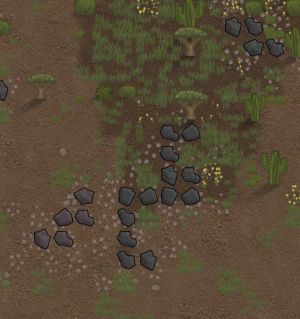Difference between revisions of "Stone chunk"
| Line 1: | Line 1: | ||
{{stub}} | {{stub}} | ||
| + | |||
| + | [[File:RockChunks.jpg|300px|thumb|right|A collection of rock chunks in their natural habitat.]] | ||
| + | |||
A '''rock chunk''' is any stone chunk, either found throughout the world naturally or spawned with a ~25% chance for each tile of rock mined. Each type of rock will spawn its own chunk, so mining marble will spawn a marble chunk. Each chunk can be cut at the [[stonecutter's table]] to yield 20 [[Resources#Materials|Stone blocks]] of the same kind. Rock chunks cannot be sold without first being turned into blocks. | A '''rock chunk''' is any stone chunk, either found throughout the world naturally or spawned with a ~25% chance for each tile of rock mined. Each type of rock will spawn its own chunk, so mining marble will spawn a marble chunk. Each chunk can be cut at the [[stonecutter's table]] to yield 20 [[Resources#Materials|Stone blocks]] of the same kind. Rock chunks cannot be sold without first being turned into blocks. | ||
A typical flat 250x250 map will contain about 600 to 900 chunks of each stone type for maps with two stone types ''or'' 400 to 600 chunks of each stone type for maps with three stone types. Once the natural supply has run out and they can no longer be spawned by mining, the last non-mod method to obtain infinite chunks is to [[deep drill]] in an area that contains no underground resources. The type of chunk produced will be displayed on the deep drill's tooltip. | A typical flat 250x250 map will contain about 600 to 900 chunks of each stone type for maps with two stone types ''or'' 400 to 600 chunks of each stone type for maps with three stone types. Once the natural supply has run out and they can no longer be spawned by mining, the last non-mod method to obtain infinite chunks is to [[deep drill]] in an area that contains no underground resources. The type of chunk produced will be displayed on the deep drill's tooltip. | ||
| − | |||
| − | |||
Stone chunks will not be moved automatically, even from a home area, and must be manually designated by the player to be hauled. They can be hauled to any stockpile with the appropriate settings, however dumping stockpile zones default settings include rock chunks. | Stone chunks will not be moved automatically, even from a home area, and must be manually designated by the player to be hauled. They can be hauled to any stockpile with the appropriate settings, however dumping stockpile zones default settings include rock chunks. | ||
Revision as of 23:10, 28 April 2020
| This article is a stub. You can help RimWorld Wiki by expanding it. Reason: Please add a reason . |
A rock chunk is any stone chunk, either found throughout the world naturally or spawned with a ~25% chance for each tile of rock mined. Each type of rock will spawn its own chunk, so mining marble will spawn a marble chunk. Each chunk can be cut at the stonecutter's table to yield 20 Stone blocks of the same kind. Rock chunks cannot be sold without first being turned into blocks.
A typical flat 250x250 map will contain about 600 to 900 chunks of each stone type for maps with two stone types or 400 to 600 chunks of each stone type for maps with three stone types. Once the natural supply has run out and they can no longer be spawned by mining, the last non-mod method to obtain infinite chunks is to deep drill in an area that contains no underground resources. The type of chunk produced will be displayed on the deep drill's tooltip.
Stone chunks will not be moved automatically, even from a home area, and must be manually designated by the player to be hauled. They can be hauled to any stockpile with the appropriate settings, however dumping stockpile zones default settings include rock chunks.
Chunks provide decent cover (50% as opposed to a tree's 25% or sandbags' 57%). Together with the fact they are omnipresent on natural maps, they are useful in firefights and will be used by the AI. Considering they can be easily hauled, it is a good idea to remove them from places the enemy could use and form your own makeshift barricades with them - whether when attacking enemy settlements or defending against raiders.
